Abstract
The article presents the results of the authors' research, the subject of which is innovative ecosystems creative class and growth drivers necessary for the implementation of a technological breakthrough in the new knowledge economy. Given in the article analytical material on the economic history of the mankind development for the last 2000 years allowed identifying empirically the main triggers that affected the thinking paradigm shift and predetermined the subsequent exit of mankind from the Malthusian trap. For this matter the authors demonstrated the differences in the world productivity and showed the stages of regional economies dominance for the period from 1 to 2001. The studied system of values and types of democracies allowed a more holistic view on the structure of cultural waves and lead to understanding of the world economic picture in terms of changing the thinking paradigm. The educts correspond to the forecast only partially, because they attribute most of the explanatory power to some hard-type factors, but do not confirm the expectations caused by mild factors. The authors believe that this study offers a valuable look at how the creativity of the creative community, being implemented at various stages in the country's management system, could bring new growth drivers, increase innovation efficiency and build a more advanced innovation ecosystem.
Keywords: Thinking paradigmmalthusian trapcreative classdriversinnovationecosystem
Introduction
Throughout the mankind development history there were a few countries leaders stood out in the world, so in the period from 201 to 300 the "golden age" of India began under the rule of the Gupta dynasty, and the flowering of science, art, literature, astronomy and philosophy fell on the reign of the Chalukya, Chera, Chola, Kadamba, Pallava and Pandya dynasties. At the same time, Ancient Rome, as one of the leading civilizations of the Ancient World, is experiencing a period of instability "The Crisis of the Roman Empire of the III century" (Erdkamp, 2016).
Starting from 600 to 1600 the leading positions in the world are held by the imperial dynasties of China (Wen, 2016). Later in the Renaissance, Europe's economies began to show its dominance in the world - Italy, Portugal and Spain. Then from 1778 to 1914 during the industrial revolution, France, Great Britain and the Netherlands occupied the central place in the world. From 1914 to 1945 there was a crisis in the European system of world economy. After the Second World War, noticeable growth occurred in the United States, in post-war Germany, Japan and the Soviet Union.
Until 1800, in pre-industrial societies, neither growth in food production per capita nor improvement in the living conditions of the population of countries has been observed (Grinin et al., 2009). When reached the maximum residence density of population it was usually dissipated by catastrophic depopulations such as war, an epidemic or famine.
Studies show that in the first year, India and China accounted for one-third and one-quarter of .the world's population, respectively. Therefore, it is not surprising that they also managed one-third and one-fourth of the entire world economy, respectively.
Figure
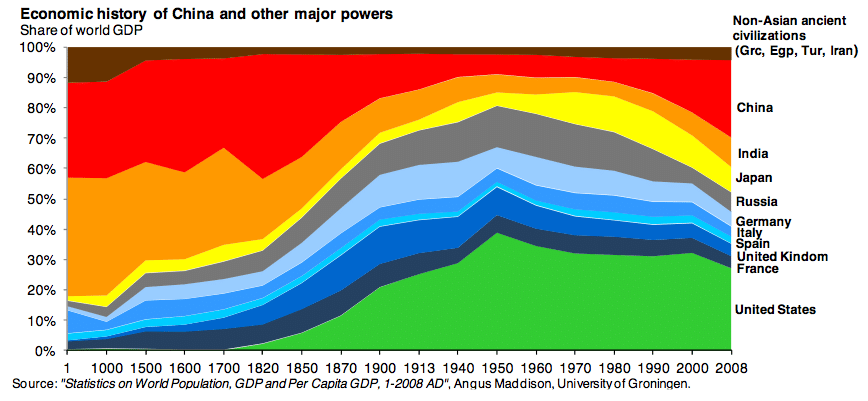
As it can be seen from Figure
The Malthusian Trap is understood as the theory that, as population growth is ahead of agricultural growth, there must be a stage at which the food supply is inadequate for feeding the population (Korotaev et al., 2011).
In his diagram (Figure
Problem Statement
The Malthusian Trap
Using the original Angus Maddison data set from the Maddison-Project database, the authors of the article constructed population dynamics of countries for the period from 1 to 2030 (forecast), which also confirms the empirical findings of Derek Thompson.
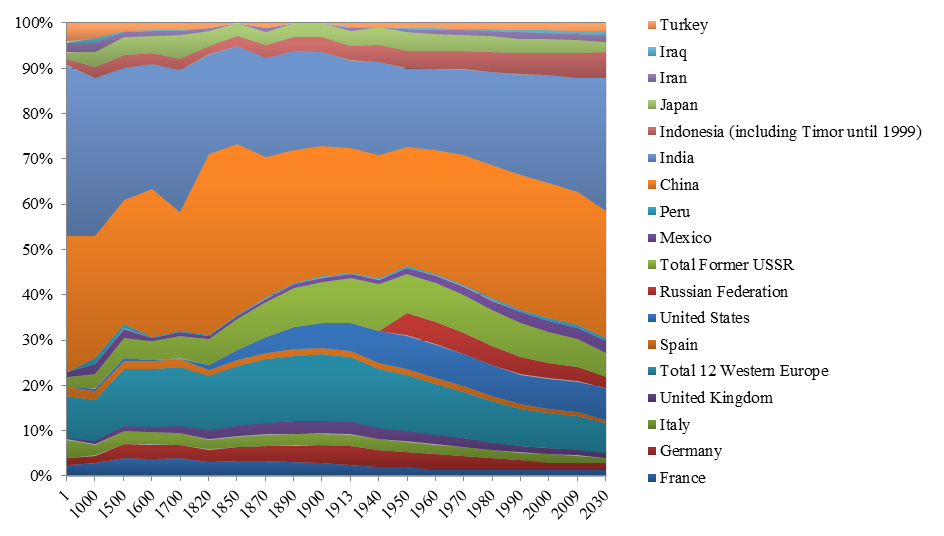
Analysis of economic literature shows that in the era of "Great geographical discoveries" from the middle of the XV century to the second half of the XVII century, creative people with entrepreneurial skills got the opportunity to escape beyond the boundaries of their tribal community or "comfort zone". During this period, mostly Europeans discovered new lands, in particular, paved the sea routes to the "New World": Africa, America, India, Asia and Oceania. Later the Columbian exchange (Crosby, 1972) took place, which was the widespread transfer of plants, animals, culture, human populations, technology, and ideas between the Americas and the Old World. Invasive species, including communicable diseases, were a byproduct of the Exchange. In that context, the exchange among civilizations was growing, which became an important stage in the formation and development of the creative community of the world as a whole, by concentrating the early growth drivers of innovative ecosystems in certain regions (England, the Netherlands, Spain, Italy, Portugal, etc.).
According to Marx and Ryazanskaya (1977), the great revolutions occurred in trade in the sixteenth and seventeenth centuries in connection with geographical discoveries and the rapidly developing merchant's capital. They constitute one of the main points that contributed to the transition from the feudal mode of production to capitalism.
In the preface of his book, "A Contribution to the Critique of Political Economy," Marx wrote: "In the social production of their existence, men inevitably enter into definite relations, which are independent of their will, namely relations of production appropriate to a given stage in the development of their material forces of production. The totality of these relations of production constitutes the economic structure of society, the real foundation, on which arises a legal and political superstructure and to which correspond definite forms of social consciousness"(Marx & Ryazanskaya, 1977, p.32).
Empirically this transition from one stage of development to another is clearly observed on the totality of the data presented in the diagrams and figures given in this article. It can be seen that the new stage in the development of society required economic actors to use more rational methods of production and available resources each time, and it is clearly visible that there was a need for better education.
The dynamics of the evolution of education (Figure
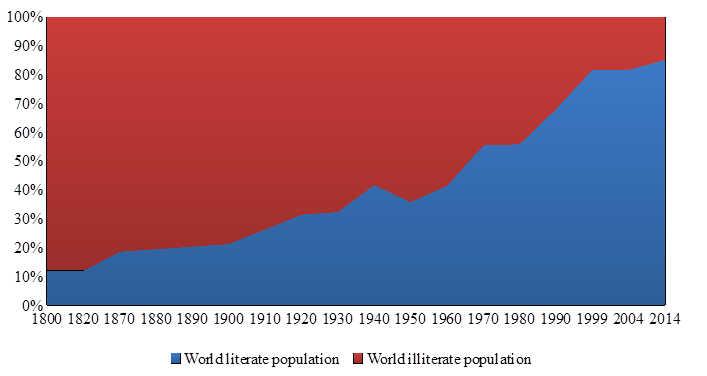
With creative community occurrence, the basic conditions were settled, which were the first growth drivers of the innovative ecosystems in the world.
Knowledge evolution
Today, through the retrospection of the change in the generations of schools and "universities," one can see a picture of the world that dominated in different historical periods, within which begin to be clearly visible the trigger points, the future basis of "industrial revolutions".
In 2000, Scott (2000) published his version of the link between the evolution of universities and the evolution of human knowledge and development of civilization (Figure
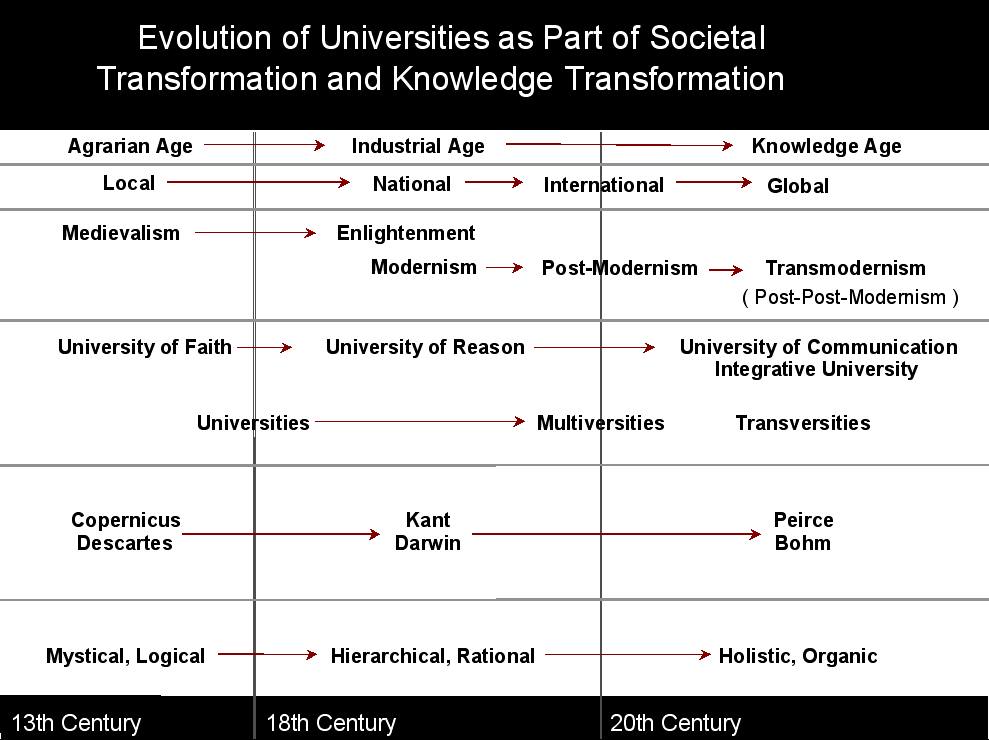
Since the creation of the first university in the 8th century, universities have undergone a significant transformation. Emerging as the Universities of the Faith, their knowledge was often open only to the authorities, they trained officials, diplomats, military leaders and taught grammar, rhetoric and philosophy, as well as natural sciences - arithmetic, geometry, music and astronomy. This regime lasted for 500 years:
1088 – University of Bologna
1096–1167 – University of Oxford
1134 (charter granted in 1218) – University of Salamanca
1209 (charter granted in 1231) – University of Cambridge
Since 1209 there has been an active process of dissemination and education, mainly in Europe, the leading universities of the world, which are active today: Oxford University, Cambridge University, University of Padua, etc.
As a result of the Enlightenment, universities transformed from the Universities of the Faith to Reason. Parallel transformations took place in a society with a world economic structure. The agrarian era was replaced by an industrial one.
Between 1820 and 1875 just at the peak of the rapid spread of the transport technologies such as railways and steamships there was an increase in the mobility of people and their concentration in the first urban clusters (Karayalcin, 2016).
The development of the urban economy required talented young people and specialists. New views, talents and creativity were accumulated in the first points of attraction - urban clusters. Studies show that a cluster is a group of interconnected organizations (companies, corporations, universities, banks, etc.) concentrated in a certain territory, which can be considered as an independent unit with certain properties.
This definition shows that universities occupy the central link in the cluster, and now the economic growth of countries in the world depends on the level of education and costs on science.
Today in most of the countries basic education is perceived not only as a right, but also as a duty of the government to create unconditional guarantees within the framework of which access to the population for basic education is granted.
This was not always so: the promotion of these ideas began in the middle of the XIX century, when most modern industrialized countries began to expand primary education, mainly due to public finances and state intervention. Data from this early period show that public funds for financing the expansion of education come from different sources, but specifically a decisive role is given to the taxes at the local level. The historical role of local public school funding is important to help us understand changes or perseverance in regional disparities.
The second half of the 20th century marked the beginning of the expansion of education as a global phenomenon. Available data show that by 1990, public expenditure on education as a share of national income in many developing countries was already close to the average in developed countries.
Expenditures for higher education are presented in Figure
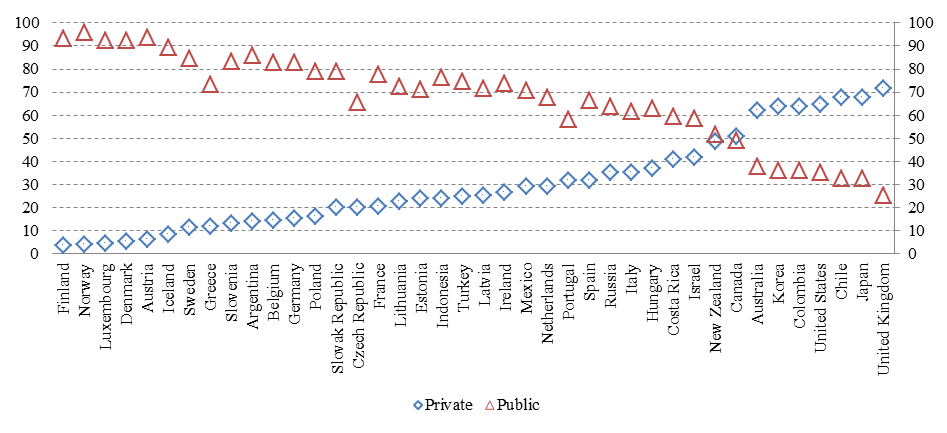
This global expansion of education in the twentieth century led to a historic decline in education inequalities around the world: in the period 1960-2010, education disparities declined each year for all age groups and in all regions of the world. Recent estimates of educational disparity by age group indicate that developing countries still have to expect further reductions in school inequality.
Research Questions
Research questions for this present study are:
Purpose of the Study
The objectives of this study are:
To study how the democracies values and types system affects the innovative ecosystems global growth drivers.
Research Methods
Empirical analysis
In 2000, Don Edward Beck made a presentation for the World Forum in New York, and then in 2001 published an article " Stages of Social Development: The Cultural Dynamics that Spark Violence, Spread Prosperity, and Shape Globalization " in which indicated that the change of social paradigms look more like waves than steps (Beck, 2000).
According to Beck and Cowan (2009), any social system contains previously calibrated code of all previous ones and in this sense any country is a set of complex historical layers and principles of organization. At the same time, collective thinking forms glue, which holds together the group, self-defines the group and reflects that place on the planet that it inhabits. Cultural waves, like matryoshkas, consist of unique elements, survival codes, myths of origin, artistic forms, life styles and general sensations.
Alan Tonkin developed this approach and showed how different values affect the development of democracy in countries (Figure
From Figure
The foundation of the creative community was new benchmarks on values in the field of innovations and cardinal reforms that took place at the turn of the 1800s (Ferreira et al., 2016), which subsequently led to the transformation of the social system of the world community, emergence of new professions that had a significant growth in productivity around the world (Attar, 2015).
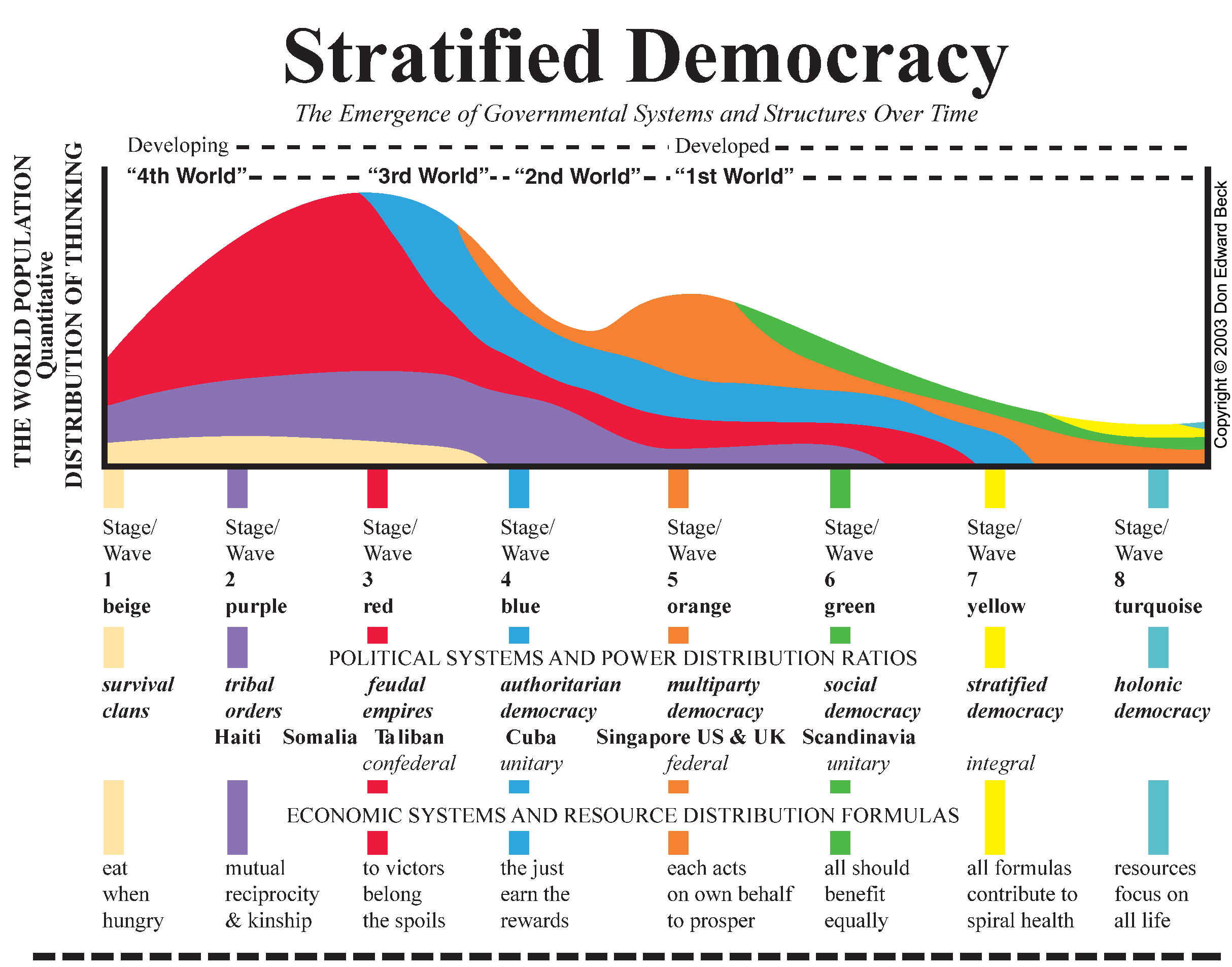
With the advent of the alphabet, records, printing, newspapers and lately Internet, a rapid growth of a strong creative community takes place in society, which affects value systems and types of democracies, reduces waves in time (Figure
Currently, the term "globalization" refers to the process of global economic, social, political integration and unification (Novikova, 2009).
Modern innovations contribute to accelerating globalization, opening up new opportunities for social and economic development, meanwhile they create serious problems that result in crises, poverty and inequality both within society and between countries.
In the era of "Network Globalization" the economy is expressed in accelerating the speed of capital transactions and their scale, the growth of international trade in comparison with GDP growth. The diagram 7 shows how GDP the per capita has changed in the world.
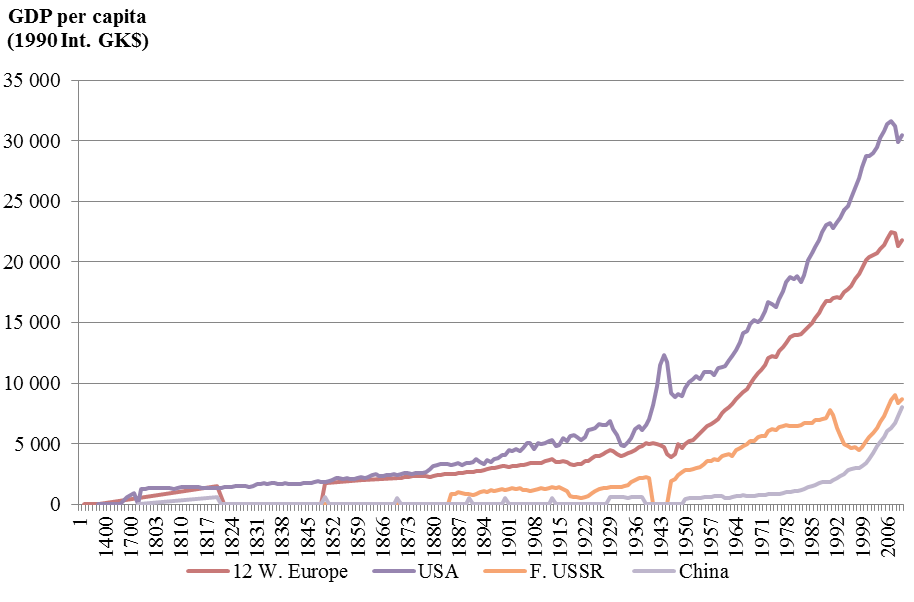
This feature is also confirmed by the study, which was conducted by Jamus Lim, a specialist of the World Bank. In Figure
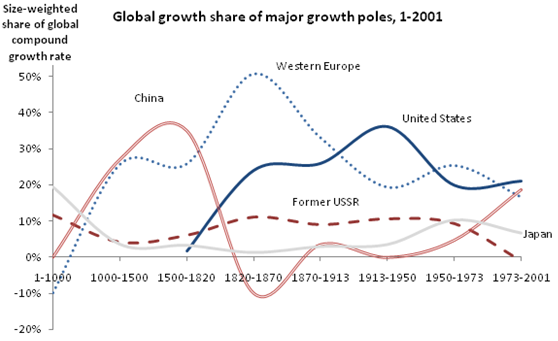
The authors understand the term "Network Globalization" as the process of continuous changes aimed at integrating national economies into a single world economy infrastructure using the network platform of a market economy.
Undoubtedly, globalization aims to accelerate the exchange of goods and products, information, knowledge and cultural values, and thanks to unprecedented growth in technologies we can see the acceleration as well in communications, science, transport and industry. Global integration increasingly causes erosion and sometimes even the destruction of national sovereignty of states.
In this regard, the main task of the creative community in modern society is the generation of non-standard and innovative ideas, as well as their implementation in practice. Accelerated exchange of innovative goods and products, information, knowledge and cultural values leads to a process of accelerating scientific and technological progress in the world.
Authors believe that the acceleration process was caused by the introduction of network platforms, which are already a key link in the global economy. This structure is actively used by many leading companies and scientific centers, which are at the forefront of the innovative economy. Their full implementation and usage in practice allows achieving acceleration in scientific and technological progress and with the use of modern methods and tools such as artificial intelligence, there will be a transition to more creative work. The future of modern universities and scientific schools depend on how quickly they can integrate the network platform into their structure and create a universal self-organizing innovative ecosystem around themselves.
Undoubtedly, the high level of development of the economy of any country depends on the introduction and use of advanced technologies, as well as on the level of education and science in general.
Today, Western countries are spending more on research and development than in Russia, so the European Union spends an average of $ 337.9 billion on research and development (Figure
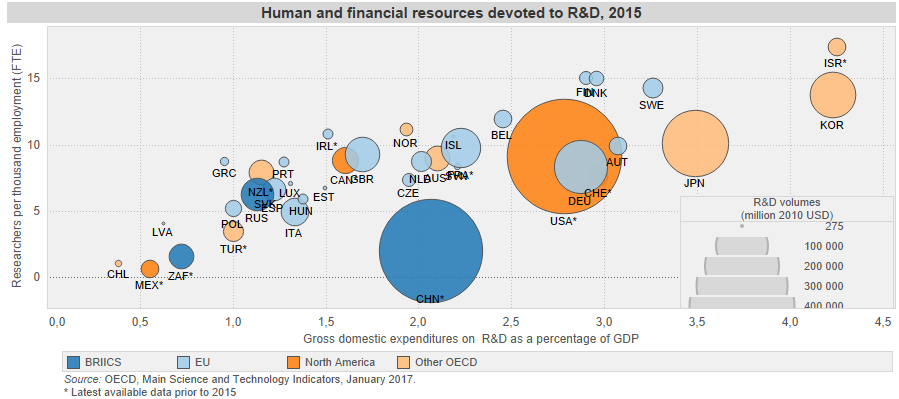
In 2015, the US spent more than $ 462.7 billion on R & D. In turn, China over 376.8 billion dollars and Japan 155.8 billion dollars. Figure
In 1965, an American architect, futurist and inventor Richard Buckminster Fuller (1895-1983), together with an assistant, artist and sociologist John McHale (1922-1978), published an illustration to the report "Shrinking of Our Planet" (Fuller, Buckminster, & McHale, 1965).
The figure shows how the evolution of vehicles and communication media compresses the size of the Earth and speeds up the travel time. It should be noted that this analysis allowed R. Fuller to be the first who pointed out the long-term trends of industrialization and globalization in the 1930s.
In turn, Gordon E. Moore in 1965 pointed to the acceleration curve of computational technologies and derived the " Moore’s law" (Papon, 2017; MacK, 2015) (Figure
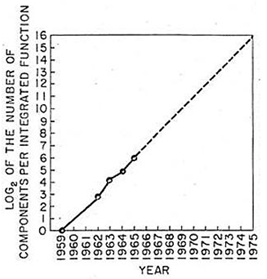
R. Fuller like E. Moore used his comprehensive approach to compare the global impact to the development of smaller and more efficient technologies of what he called "accelerating acceleration" and "ephemeralization."
According to Karl Rupp, who studied the 40-year statistics of the development of microprocessors dynamics (Figure12), in the near future we will see an increase in the number of nuclei in proportion to the number of transistors, but this significant leap in development will be provided by the transition to more modern algorithms that will implement massive parallel computations (Rupp, 2018). These data also correlate with the data published in Ray Kurzweil's book "The singularity is near: When humans transcend biology" (Kurzweil, 2005).
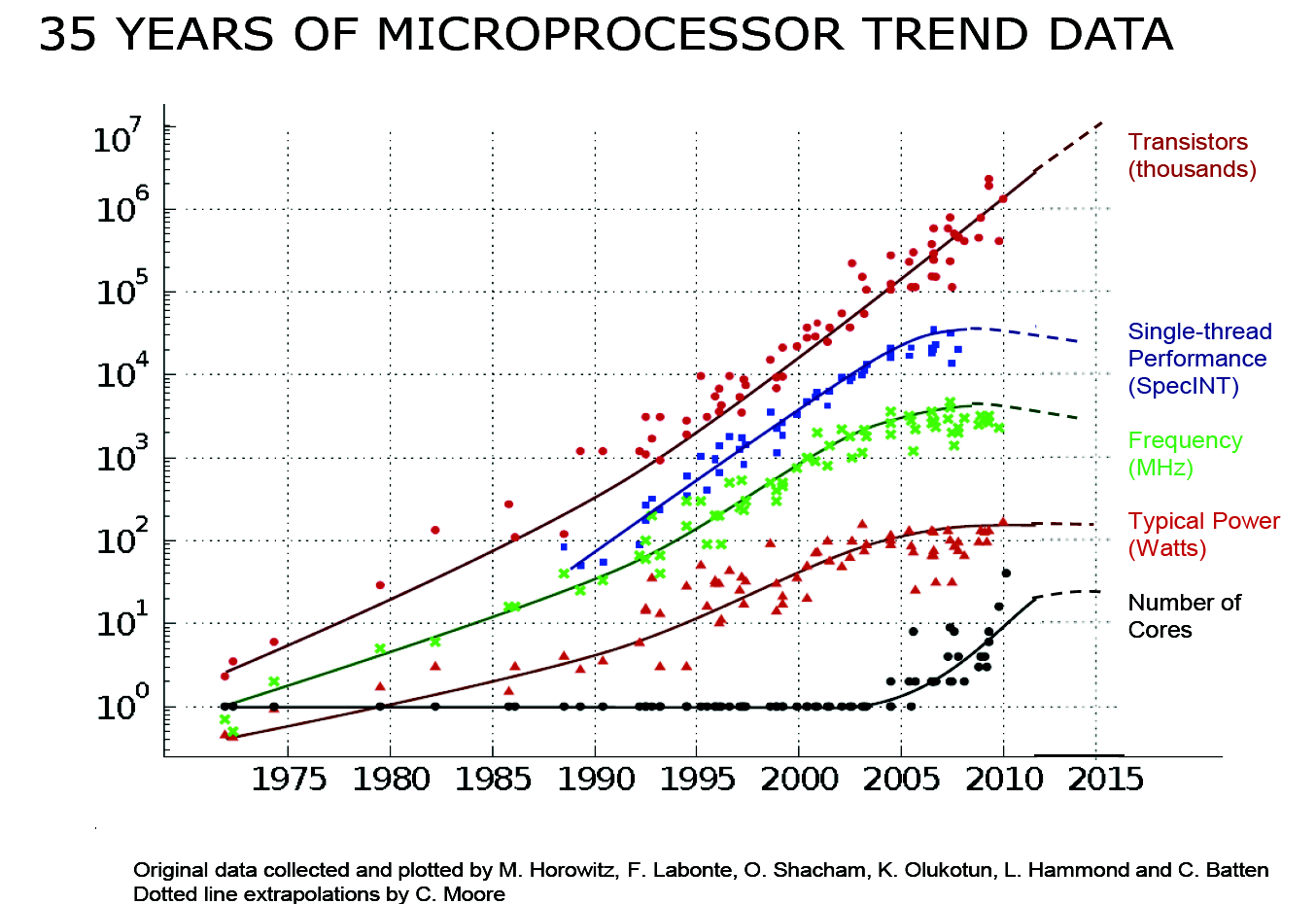
The presented research shows that recently the structure of the world economy has changed rapidly under the innovation trend. The structure is already united by network platforms and the processes taking place in the world is bound to intensify and create technological backwardness of developing countries. It is empirically evident that the rate of such changes grows nonlinearly and there are limits that can restart the entire development in the furure. What this phenomenon will lead to – a new paradigm of thinking, new growth drivers or a creative community that requires changes – the question remains open.
Findings
The considered historical process of changing the paradigm of thinking indicates that for effective development of the creative class it is necessary to create new growth drivers in the form of expanded innovative ecosystems on a network basis.
The conducted research shows that the flowering of ecosystems around the world should be considered in the broader context, within the framework of the socio-economic structural shift.
Thus, the information age business revised the basic work principles of the most enterprises with out of date technologies, and it became a determining factor in the economic growth of new digital corporations.
This structural shift could not go unnoticed, as Mark Andressen in his essay "Why Software is Eating the World" (Andreessen, 2011) noted that modern technology companies are invading and overturning the previously created industry structures, and the Deloitte monitors these estates every year and publishes the "The Shift Index", which shows how the global business environment is being transformed under the impact of public policy and the exponential growth rate in the digital infrastructure.
Meanwhile, the famous group of researchers of Richard Florida "Creative Class Group" has published many books on this topic, including " Rise of the Creative Class ", which shows how the new economic class of people becomes the key to the future of our cities.
The study of foreign experience in the field of innovation policy shows that the following conditions are necessary for the formation of effective national innovation ecosystems:
Scientific, innovation and production clusters can activate and develop creative community innovation activities in the scope of introduction of breakthrough developments and technologies.
It is important to take into account the interests of all the participants to form the cluster, relying on the personal interest primacy law. Only the unification and coordination of the system directives with the personal interests of its participants will ensure its effective functioning. Otherwise, this will weaken the position of the entire cluster as a whole. A similar problem arises with the artificial creation of systems by order of superiors, this problem can be solved by means of face-to-face communications.
Thus, the wide development of national innovation ecosystems and clusters in the country may indicate that the state chooses an innovative way as the main development strategy, rather than a raw material economy and is aimed at global technological leadership in a rapidly developing world.
Conclusion
Considering the latest technologies will be the growth driver of all the changes, and the fact that the world of technologies in the XIX century has become global, the authors support the view that the implementation of international cooperation can be considered as one of the processes of the global growth.
Transition outlines to the new technological way are clearly visible even at present moment, its growth will lead to the formation of new global markets based on a whole complex of innovative technological solutions with fundamentally new products and services. This time can be called a "point of design" or a window of opportunity for the development of regional economies of countries and their entrepreneurs.
However, question of the leadership in this race remains open. Companies that show the best growth will obviously lead the market in the field of innovation.
A characteristic feature of the new world will be such technologies as bio- and nanotechnologies, genetic engineering, membrane and quantum technologies, photonics, micromechanics, thermonuclear energy.
Synthesis of achievements in the above areas will lead to the development of the following developments: a quantum computer, artificial intelligence, which will ultimately change the entire management system (state, society, economy) of the region and generate a new world economy based on the new social principles of society management.
Given the explosive nature of modern innovations, the ubiquitous penetration of digital platforms and highly integrated intellectual environments into all spheres of human activity, humanity faces one global question: what place a person will take in a digital environment where the world will be ruled by highly massive parallel computing.
The authors of the article conclude that, today, humanity, like 250 years ago, is also on the verge of getting out of the "Malthusian trap", and it's better to call it the "Digital Trap". The way out should be done by creating a better environment based on such an ecosystem, where the creative class can find new growth drivers, change the established paradigm of thinking and escape from the "Digital Trap".
In our opinion, the following main trends can set the new growth trajectory:
joint work in the field of international standardization.
References
- Andreessen, M. (2011). Why software is eating the world. The Wall Street Journal. URL: https://www.wsj.com/articles/SB10001424053111903480904576512250915629460. Accessed 15.08.2018.
- Attar, A.M. (2015). Entrepreneurship, knowledge, and the industrial revolution. Economics: the Open-Access, Open-Assessment E-Journal, 9(2015-3), 1–54. DOI:
- Beck, D. (2000). Stages of social development. The cultural dynamics that spark violence, spread prosperity, and shape globalization. New York. URL: http://spiraldynamics.net/DrDonBeck/essays/stages_of_social_development.htm. Accessed 19.08.2018.
- Beck, D., & Cowan, C.C. (2009). Spiral dynamics: mastering values, leadership, and change; exploring the new science of memetics. Oxford: Blackwell.
- Cohen, T. (2016). Escape velocity: hyperpopulation, species splits, and the counter-malthusian trap (after 'tipping points' pass). Oxford Literary Review, 38(1), 127-148. DOI:
- Crosby, A.W. (1972). The Columbian Exchange: biological and cultural consequences of 1492, Westport, Conn.: Greenwood Press.
- Erdkamp, P. (2016). Economic growth in the Roman Mediterranean world: an early good-bye to Malthus? Explorations in Economic History, 60, 1-20. DOI:
- Ferreira, P.C., Pessôa, S., & Dos Santos, M.R. (2016). Globalization and the industrial revolution. Macroeconomic Dynamics, 20(3), 643-666. DOI:
- Fuller, R., Buckminster, A., & McHale, J. (1965). Shrinking of our planet. Courtesy of the estate of R. Buckminster Fuller. In K. Börner & E.F. Hardy (Eds.), 4th Iteration (2008): Science Maps for Economic Decision-Makers, Bloomington: Places & Spaces: Mapping Science. URL: http://scimaps.org.
- Grinin, L.E., Malkov, S.Yu., Gusev, V.A., & Korotayev, A.V. (2009). Some possible directions of development of the theory of social-demographic cycles and the mathematical models of exit from the Malthusian trap. In S.Y. Malkov, L.E. Grinin & A.V. Korotayev (Eds.), History and Mathematics: processes and models (pp. 134-210). Moscow: Librocom/URSS.
- Hagel, J., Seely Brown, J., Wooll, M., & de Maar, A. (2016). The paradox of flows: can hope flow from fear? Shift Index. 2016. Shift Index Series. Deloitte University Press. URL: https://www2.deloitte.com/content/dam/insights/us/articles/3407_2016-Shift-Index/DUP_2016-Shift-Index.pdf. Accessed 19.08.2018.
- Karayalcin, C. (2016). Property rights and the first great divergence: Europe 1500-1800. International Review of Economics and Finance, 42(C), 484–498.
- Korotaev, A.V., Khalturina, D.A., Kobzeva, S.V., & Sinicyna, Yu.V. (2011). Trap on the way out of the trap? On some features of political and demographic dynamics of modernizing systems. In A.A. Akayev, A.V. Korotayev, G.G. Malinetskii & S.Y. Malkov (Eds.), Projects and risks of the future. Concepts, models, tools, forecasts (pp. 45-88). Moscow Krasang/URSS.
- Kurzweil, R. (2005). The singularity is near: When humans transcend biology. New York: Viking.
- Lim, J. (2010). Long swings in global growth drivers. The World Bank Group. URL: http://blogs.worldbank.org/prospects/long-swings-in-global-growth-drivers-0. Accessed 19.08.2018.
- MacK, C. (2015). The multiple lives of Moore’s Law. IEEE Spectrum, 52(4), 31–37.
- Marx, K., & Ryazanskaya, S.W. (1977). A contribution to the critique pf political economy. Moscow: Porgres Publ.
- Moore, G.E. (1998). Cramming more components onto integrated circuits. Proceedings of the IEEE, 86(1), 82-85. DOI:
- Novikova, I.V. (2009). Globalization, the state and the market: a retrospective and the prospect of interaction. Minsk, Belarus: Acad. Mng. under the President of the Republic.
- OECD. (2017). OECD Factbook 2017: economic, environmental and social statistics. Paris: OECD Publishing. URL: http://www.oecd.org/innovation/inno/researchanddevelopmentstatisticsrds.htm.
- Papon, P. (2017). Moore's law anticipates the future of electronics (futures of yesteryear). [La loi de Moore anticipe ravenir de l'électronique]. Futuribles: Analyse Et Prospective, 2017-March (417), 79-84.
- Rupp, K. (2018). 40 years of microprocessor trend data. URL: https://www.karlrupp.net/2015/06/40-years-of-microprocessor-trend-data/. Accessed 19.08.2018.
- Scott, D.K. (2000). Spirituality in an integrative age. New York: Peter Lang Publishing.
- Thompson, D. (2012). The economic history of the last 2,000 years in 1 little graph. The Atlantic. URL: https://www.theatlantic.com/business/archive/2012/06/the-economic-history-of-the-last-2-000-years-in-1-little-graph/258676. Accessed 21.08.2018.
- Tonkin, A. (2017). Different values: different democracy. Center for Human Emergence Middle East. URL: http://www.humanemergencemiddleeast.org/different-values-different-democracy-alan-tonkin.php/. Accessed 20.08.2018.
- Wen, Y. (2016). The making of an economic superpower: unlocking China's secret of rapid industrialization. Singapore: World Scientific Publishing Co Pte Ltd. DOI:
Copyright information

This work is licensed under a Creative Commons Attribution-NonCommercial-NoDerivatives 4.0 International License.
About this article
Publication Date
20 March 2019
Article Doi
eBook ISBN
978-1-80296-056-3
Publisher
Future Academy
Volume
57
Print ISBN (optional)
-
Edition Number
1st Edition
Pages
1-1887
Subjects
Business, business ethics, social responsibility, innovation, ethical issues, scientific developments, technological developments
Cite this article as:
Polyakov, R., & Gordeeva, E. (2019). Thinking Paradigm Shift: Innovative Ecosystems Creative Class And Growth Drivers. In V. Mantulenko (Ed.), Global Challenges and Prospects of the Modern Economic Development, vol 57. European Proceedings of Social and Behavioural Sciences (pp. 373-387). Future Academy. https://doi.org/10.15405/epsbs.2019.03.38

